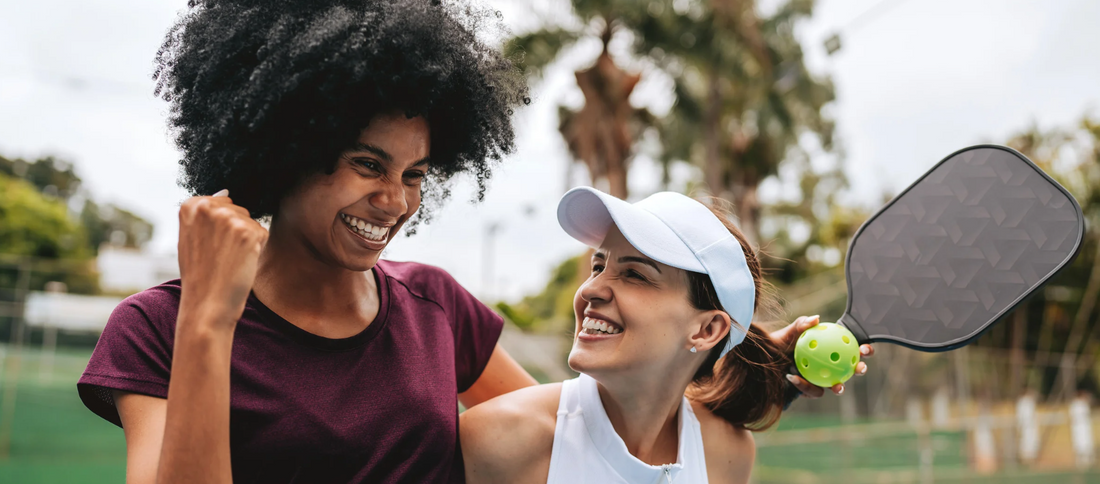
The Hidden Language of Pickleball: Nonverbal Communication During Play
Share
Pickleball is a sport often defined by strategy, shot selection and reflexes. But for seasoned players, especially in doubles, there’s a nuanced element that often goes unnoticed by casual observers: the silent dialogue between partners. Nonverbal communication — gestures, glances, body positioning and subtle cues — can elevate a team from competent to cohesive.
This “hidden language” is the connective tissue of elite play. It anticipates movement. It aligns intentions. It preserves momentum. In this article, we will uncover how nonverbal communication impacts decision-making, boosts synergy and keeps partners fluid in motion and mindset.
The Unspoken Fundamentals: Why Nonverbal Cues Matter
Words on the court are important, but there’s limited time during play for extended chatter. Rallies can unfold in milliseconds. When verbal instruction is too slow or inappropriate mid-point, players must rely on intuitive signals to maintain cohesion.
Benefits of strong nonverbal communication include:
- Preemptive coordination: Anticipating your partner’s next move before it happens
- Reduced hesitation: Faster transitions during fast-paced points
- Spatial awareness: Adjusting positioning without crowding your teammate
- Trust and flow: Reading each other’s energy helps manage tempo and morale
In doubles, every paddle swing and court shift tells a story. The better you read and express this unspoken dialogue, the more effective your team becomes.
Positioning as Communication: Where You Stand Speaks Volumes
Your court location isn’t just tactical. It’s informational.
Examples of positional language include:
- Shifting forward to the kitchen signals readiness to attack or dink
- Hanging back near the baseline may imply caution or awaiting a drop
- Leaning slightly left or right suggests your preferred coverage area
- Center coverage with a paddle held low communicates openness to defend resets
A good partner will recognize these visual markers and adjust their own positioning accordingly. Over time, it becomes an instinctual dance — like two magnets balancing on a tightrope.
Eye Contact: The Quickest Check-In
In the heat of a match, eye contact becomes a lightning-fast confirmation system. It can be used to signal:
- Readiness before a serve or return
- Agreement on court strategy (e.g., poaching, stacking)
- Acknowledgment of a miscue without verbal correction
- Focus resets after a lost point
Even just a fraction-of-a-second glance can reestablish connection, especially after chaotic exchanges. It assures your partner that you’re mentally engaged and synced.
Paddle Placement: A Silent Signal System
One of the most underutilized forms of doubles communication is paddle placement during pre-serve formations, especially in stacking situations.
Some common paddle cues include:
- Paddle pointing down: Standard formation, no stack
- Paddle to the side or behind back: Indicates a stack or switch is coming
- Holding the paddle close to the hip: A readiness signal to serve or receive
- Extended paddle after a rally: Nonverbal “let’s reset” or “take a breath”
When practiced consistently, paddle gestures become a shorthand strategy board between partners.
Body Language: Attitude Without Words
Beyond tactical cues, your body speaks volumes about your mindset. Positive posture and expressive energy help fuel your partner’s confidence.
Constructive nonverbal signals include:
- Paddle taps or fist bumps after points to reinforce team cohesion
- Staying upright and relaxed even after errors to project calm
- Walking back together between points rather than separating
- Eye rolls, sighs or shoulder drops should be minimized, as they often deflate partner morale even when unintentional
Remember, your demeanor is contagious. Use it as a motivational tool, not a pressure valve.
Reading Opponents: Interpreting Their Silent Signals
Nonverbal communication isn’t just an intra-team advantage. Observing your opponents can provide tactical insights.
Watch for cues such as:
- Paddle grip changes before serve (topspin or slice)
- Movement patterns that predict poaches or lobs
- Hesitant footwork that may indicate weak backhand coverage
- Lack of eye contact between them after errors, suggesting poor synergy
Advanced players capitalize on these tells, building anticipation and strategic misdirection into their own game.
Training the Silent Dialogue
While nonverbal communication may seem instinctive, it can be deliberately cultivated. Great teams train it just like drop shots or resets.
Ways to enhance your nonverbal fluency include:
- Shadow drills: Practice court coverage and positioning without a ball
- Silent point games: Play entire games without verbal communication
- Video review: Analyze past matches and identify subtle cues or breakdowns
- Pre-match rituals: Establish visual signals for switches, tempo shifts and shot sequences
The more fluent your nonverbal exchanges, the more seamless your execution under pressure.
Conclusion: Play Beyond Words
In the realm of high-level pickleball, speech is secondary to synchronization. Mastering the hidden language of the game turns your partnership into a dynamic, responsive unit that adapts in real time. Whether it’s a sideways glance, a subtle step or the angle of your paddle, every detail can tip the balance.
So the next time you step onto the court, listen not just with your ears but with your eyes. Communicate through motion. Connect through rhythm. Because in pickleball, the strongest teams often speak the least — and say the most.












